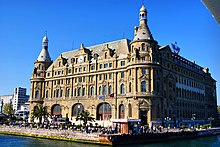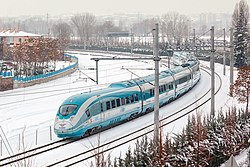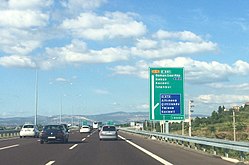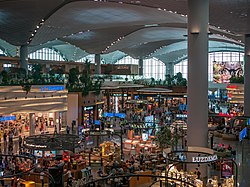Transport in Turkey

Transport in Turkey is road-dominated and mostly fuelled by diesel.[1] Transport consumes a quarter of energy in Turkey,[2] and is a major source of air pollution in Turkey and greenhouse gas emissions by Turkey.
Rail transport[]
Rail network[]



The TCDD – Türkiye Devlet Demir Yolları (Turkish State Railways) possess 10,984 km of 1,435 mm (4 ft 8+1⁄2 in) gauge, of which 2,336 km are electrified (2005).[5]
There are daily regular passenger trains all through the network.[6] TCDD has started an investment program of building 5.000 km high-speed lines until 2023. As of October 2019, three high speed train routes are running: Ankara-Eskişehir-İstanbul, Ankara-Konya and İstanbul-Eskişehir-Konya.
The freight transportation is mainly organized as block trains for domestic routes, since TCDD discourages under 200 to loads by surcharges.
Urban rail[]

After almost 30 years without any trams, Turkey is experiencing a revival in trams. Established in 1992, the tram system of Istanbul earned the best large-scale tram management award in 2005. Another award-winning tram network belongs to Eskişehir (EsTram) where a modern tram system opened in 2004. Several other cities are planning or constructing tram lines, with modern low-flow trams.
By 2014, there have been 12 cities in Turkey using railroads for transportation.
- Cities with commuter rail systems: Istanbul, Ankara, Izmir, Gaziantep(very soon)
- Cities with metro systems: Istanbul, Ankara, Izmir, Bursa, Adana
- Cities with light rail transit systems: Istanbul, Ankara, Izmir, Adana, Bursa, Eskişehir, Konya, Antalya, Kayseri, Gaziantep, Samsun, Kocaeli.
Railway links with adjacent countries[]
 Azerbaijan – via Georgia – under construction
Azerbaijan – via Georgia – under construction Armenia – closed (see Kars Gyumri Akhalkalaki railway line)[7]
Armenia – closed (see Kars Gyumri Akhalkalaki railway line)[7] Bulgaria – open – 1,435 mm (4 ft 8+1⁄2 in)
Bulgaria – open – 1,435 mm (4 ft 8+1⁄2 in) Greece – open – 1,435 mm (4 ft 8+1⁄2 in) (Note: Passenger services as Express of Friendship/Filia suspended from 13 February 2012 [8])
Greece – open – 1,435 mm (4 ft 8+1⁄2 in) (Note: Passenger services as Express of Friendship/Filia suspended from 13 February 2012 [8]) Georgia – under reconstruction – break-of-gauge 1,435 mm (4 ft 8+1⁄2 in)/1,520 mm (4 ft 11+27⁄32 in).
Georgia – under reconstruction – break-of-gauge 1,435 mm (4 ft 8+1⁄2 in)/1,520 mm (4 ft 11+27⁄32 in). Iran – via Lake Van train ferry – same gauge
Iran – via Lake Van train ferry – same gauge Iraq – No direct link, traffic routed via Syria – same gauge
Iraq – No direct link, traffic routed via Syria – same gauge Syria – closed – 1,435 mm (4 ft 8+1⁄2 in) (Note: It was suspended after breakout of Syrian Civil War in 29 August 2011)
Syria – closed – 1,435 mm (4 ft 8+1⁄2 in) (Note: It was suspended after breakout of Syrian Civil War in 29 August 2011)
Road transport[]


Road transport is responsible for much air pollution in Turkey and almost a fifth of Turkey's greenhouse gas emissions, mainly via diesel. As of 2020 there are many old, inefficient, polluting trucks.[2] Retiring old polluting vehicles by forcing all cars and trucks to meet tailpipe emission standards would reduce disease, especially from polycyclic aromatic hydrocarbons.[9] As of 2014, the country has a roadway network of 65,623 kilometres (40,776 miles).[10] The total length of the rail network was 10,991 kilometres (6,829 miles) in 2008, including 2,133 kilometres (1,325 miles) of electrified and 457 kilometres (284 miles) of high-speed track.[11][12] The Turkish State Railways started building high-speed rail lines in 2003. The Ankara-Konya line became operational in 2011, while the Ankara-Istanbul line entered service in 2014.[12] Opened in 2013, the Marmaray tunnel under the Bosphorus connects the railway and metro lines of Istanbul's European and Asian sides; while the nearby Eurasia Tunnel (2016) provides an undersea road connection for motor vehicles.[13] The Bosphorus Bridge (1973), Fatih Sultan Mehmet Bridge (1988) and Yavuz Sultan Selim Bridge (2016) are the three suspension bridges connecting the European and Asian shores of the Bosphorus strait. The Osman Gazi Bridge (2016) connects the northern and southern shores of the Gulf of İzmit. The Çanakkale Bridge, currently under construction, will connect the European and Asian shores of the Dardanelles strait.
Road network[]

There are three types of intercity roads in Turkey:
– The first is the historical and free road network called State roads (Devlet Yolları) that are completely under the responsibility of the General Directorate of Highways except for urban sections (like the sections falling within the inner part of ring roads of Ankara, Istanbul or İzmir. Even if they mostly possess dual carriageways and interchanges, they also have some traffic lights and intersections.
– The second type of roads are controlled-access highways that are officially named Otoyol. But it isn't uncommon that people in Turkey call them Otoban (referring to Autobahn) as this types of roads entered popular culture by the means of Turks in Germany. They also depend on the General Directorate of Highways except those that are financed with a BOT model.
– The third type of roads are provincial roads (Il Yolları) are highways of secondary importance linking districts within a province to each other , the provincial center, the districts in the neighboring provinces, the state roads, railway stations, seaports, and airports
- Motorways: Motorway 2.225 km (2019)
- Dual carriageways: 17.550 km [14]
- State Highways 31.021 km (2019)
- Provincial Roads 34.153 (2019)
- Motorway Projects‐Vision 5250 km (in 2023)
As of 2010, there are 155 tunnels (total length 99.5 km) and 6447 bridges (total length 296.3 km) on the network.[15][16]
Public road transport[]

There are numerous private bus companies providing connections between cities in Turkey.[17] For local trips to villages there are dolmuşes, small vans that seat about twenty passengers. As of 2010, number of road vehicles is around 15 million. The number of vehicles by type and use is as follows.[18]
- Car 7,544,871
- Minibus 386,973
- Bus 208,510
- Small truck 2,399,038
- Truck 726,359
- Motorcycle 2,389,488
- Special Purpose vehicle 35,492
- Tractor 1,404,872
- Total: 15,095,603
Cycling[]

This section needs expansion. You can help by . (December 2019) |
In 2019 a new regulation on cycle paths was issued.[19]
Escooters[]
Escooter rental is available in some cities,[20] and escooters can be used on cycle paths, and on urban roads without cycle paths where the speed limit is below 50 kph.[21]
Car ownership[]
As of 2020 over half the registered motor vehicles are cars - about 12.5 million - of which 4.7 million are diesel fueled, 4.7 million LPG, and 3 million gasoline.[22]
Air transport[]

In 2013 Turkey had the tenth largest passenger air market in the world with 74,353,297 passengers.[23] In 2013 there were 98 airports in Turkey,[24] including 22 international airports.[25] As of 2015, Istanbul Atatürk Airport is the 11th busiest airport in the world, serving 31,833,324 passengers between January and July 2014, according to Airports Council International.[26] The new (third) international airport of Istanbul is planned to be the largest airport in the world, with a capacity to serve 150 million passengers per annum.[27][28][29] Turkish Airlines, flag carrier of Turkey since 1933, was selected by Skytrax as Europe's best airline for five consecutive years in 2011, 2012, 2013, 2014 and 2015.[30][31][32] With 435 destinations (51 domestic and 384 international) in 126 countries worldwide, Turkish Airlines is the largest carrier in the world by number of countries served as of 2016.[33]
Airlines[]

Airports[]
Total number of Airports in Turkey: 117 (2007)
Airports – with paved runways
total:
88
over 3,047 m:
16
2,438 to 3,047 m:
1,524 to 2,437 m:
19
914 to 1,523 m:
16
under 914 m:
4 (2010)
(Link:[34])
Airports – with unpaved runways
total:
11
1,524 to 2,437 m:
1
914 to 1,523 m:
6
under 914 m:
4 (2010)
(Link:[34])
Heliports 20 (2010)
Water transport[]
About 1,200 km
Port cities[]
Air pollution[]
Road traffic is a major source of air pollution in Turkey,[35] and Istanbul is one of the few European cities without a low emission zone.[36][37]
Transport emitted 85 megatonnes of CO2 in 2018, about one tonne per person and 16 percent of Turkey's greenhouse gas emissions. Road transport dominated transport emissions with 79 megatonnes, including agricultural vehicles.[38]
See also[]
- Right to Clean Air Platform Turkey
- Public transport in Istanbul
- List of highways in Turkey
- Turkish State Highway System
- List of otoyol routes in Turkey
- Otoyol
Sources[]
- Difiglio, Prof. Carmine; Güray, Bora Şekip; Merdan, Ersin (November 2020). Turkey Energy Outlook. iicec.sabanciuniv.edu (Report). Sabanci University Istanbul International Center for Energy and Climate (IICEC). ISBN 978-605-70031-9-5.
- Bisiklet Yolları Klavuzu [Bicycle Path Guidelines] (PDF) (Report) (in Turkish). Ministry of Environment and Urban Planning (Turkey). December 2019.
References[]
- ^ Difiglio, Güray & Merdan (2020), p. 135.
- ^ Jump up to: a b Difiglio, Güray & Merdan (2020), p. 102.
- ^ "Velaro Turkey: High-Speed Train for TCDD" (PDF). Siemens Mobility. Retrieved 16 April 2020.
- ^ "Velaro Turkey High-Speed Train". Siemens Mobility. Retrieved 16 April 2020.
- ^ TCDD Statistics – PDF file
- ^ Uysal, Onur. "Traveling by Train in Turkey", Rail Turkey, 5 Mar 2014
- ^ Railway Gazette International – January 2008 p51
- ^ http://www.tcdd.gov.tr/home/detail/?id=233
- ^ Difiglio, Güray & Merdan (2020), p. 154.
- ^ "Yol Ağı Bilgileri". Karayolları Genel Müdürlüğü. Archived from the original on 9 November 2016. Retrieved 9 August 2014.
- ^ "CIA World Factbook: Turkey". Cia.gov. Retrieved 29 August 2011.
- ^ Jump up to: a b "Dünyada Ve Türkıyede Hizli Tren". hizlitren.tcdd.gov.tr. Archived from the original on 5 July 2014. Retrieved 12 August 2014.
- ^ "Istanbul's $1.3BN Eurasia Tunnel prepares to open". Anadolu Agency. 19 December 2016.
- ^ "Yol Ağı Bilgileri". Kgm.gov.tr. Archived from the original on 9 November 2016. Retrieved 13 January 2017.
- ^ [1][dead link]
- ^ [2][dead link]
- ^ "NUMBER OF MOTOR VEHICLES -Number of registered motor vehicles in Turkey exceeds 15 million in November 2010. – Free Online Library". Thefreelibrary.com. Retrieved 13 January 2017.
- ^ "::Türkiye Ýstatistik Kurumu Web sayfalarýna Hoţ Geldiniz". Tuik.gov.tr. Archived from the original on 5 January 2012. Retrieved 13 January 2017.
- ^ "BİSİKLET YOLLARI YÖNETMELİĞİ". www.resmigazete.gov.tr (in Turkish). Retrieved 26 December 2019.
- ^ "E-scooter company Fenix acquires Palm for $5M, gains entry to Turkish market". TechCrunch. Retrieved 12 August 2021.
- ^ "Regulation for use of e-scooter enters into force - Turkey News". Hürriyet Daily News. Retrieved 12 August 2021.
- ^ Çoban, Hasan Hüseyin (23 November 2020). "A 100% Renewable Energy System: The Case of Turkey In The Year 2050".
- ^ World Bank Datebase, http://data.worldbank.org/indicator/IS.AIR.PSGR
- ^ "CIA World Factbook: Turkey". Retrieved 17 November 2014.
- ^ "Study in Turkey: International Airports in Turkey". Archived from the original on 25 December 2013. Retrieved 17 November 2014.
- ^ "Year to date Passenger Traffic". ACI. 25 September 2014. Retrieved 25 September 2014.
- ^ "It will be the biggest airport of the world". 24 January 2013. Archived from the original on 29 January 2013. Retrieved 24 January 2013.
- ^ "Istanbul's New Erdoğan-Backed Airport to Be Named After... Erdoğan". 14 August 2014.
- ^ Gianluca Mezzofiore (14 August 2014). "Erdogan Airport: Istanbul's Super Hub 'to be Named After Turkey's President-Elect'". International Business Times UK.
- ^ "Turkish Airlines is named the Best Airline in Europe at the 2012 World Airline Awards held at Farnborough Air Show". Skytrax. 12 July 2012. Archived from the original on 25 April 2013. Retrieved 25 April 2013.
- ^ "Turkish Airlines named best airline in Europe for fifth year in a row – BUSINESS".
- ^ "Archived copy". Archived from the original on 27 August 2014. Retrieved 28 September 2014.CS1 maint: archived copy as title (link)
- ^ "Turkish Airlines: International Flight Destinations". Turkish Airlines. Archived from the original on 19 May 2016. Retrieved 22 June 2016.
- ^ Jump up to: a b "The World Factbook — Central Intelligence Agency". Cia.gov. Retrieved 13 January 2017.
- ^ "Report: Air pollution becoming more lethal in Turkey while scientists struggle to access data". Bianet - Bagimsiz Iletisim Agi. Retrieved 9 November 2020.
- ^ "StackPath". www.masstransitmag.com. Retrieved 9 November 2020.
- ^ sabah, daily (3 May 2019). "Low-emission zones for Turkish cities in the works". Daily Sabah. Retrieved 9 November 2020.
- ^ "Turkey. 2020 National Inventory Report (NIR)". unfccc.int. Retrieved 9 November 2020.
External links[]
| Wikimedia Commons has media related to Transport in Turkey. |
- Transport in Turkey

